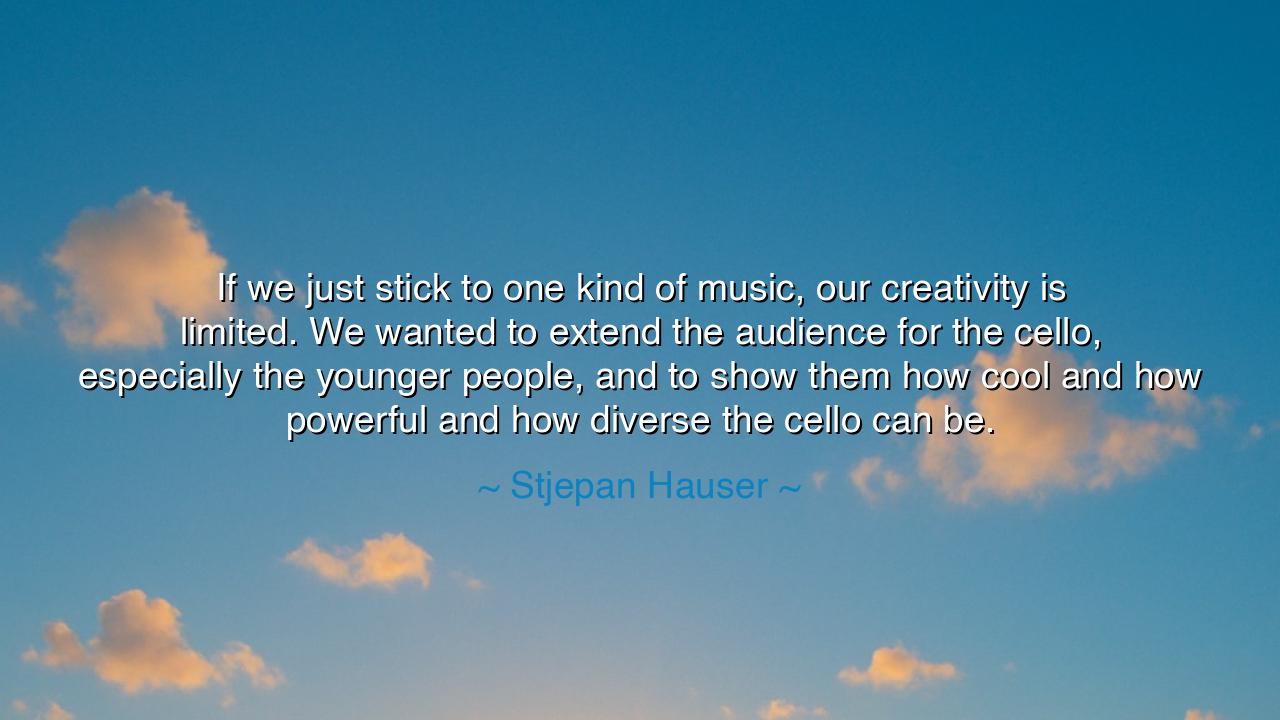
If we just stick to one kind of music, our creativity is limited.
If we just stick to one kind of music, our creativity is limited. We wanted to extend the audience for the cello, especially the younger people, and to show them how cool and how powerful and how diverse the cello can be.






"If we just stick to one kind of music, our creativity is limited. We wanted to extend the audience for the cello, especially the younger people, and to show them how cool and how powerful and how diverse the cello can be." These words from Stjepan Hauser, a renowned cellist, highlight the profound importance of diversity and creativity in art, particularly in music. Hauser’s statement speaks to the idea that artistic expression should not be confined to a single genre, style, or tradition. Creativity thrives when we allow ourselves the freedom to explore, adapt, and fuse different influences. Hauser’s vision for the cello is a reflection of the need to break down boundaries in the pursuit of innovation, connection, and growth—to show the world that instruments like the cello are not just for classical music but can resonate with a wide, diverse audience.
In the ancient world, the importance of diversity in the arts was well understood. The Greeks celebrated musical variety as a means of enhancing human experience. Pythagoras, the ancient philosopher, was one of the first to study the mathematical relationships in music, recognizing that music was not only about the melodies and harmonies but about the emotional and intellectual connection it created in the listener. The Greeks saw music as a force that could elevate the spirit, and they understood that different types of music could resonate differently with individuals, creating a wide array of emotional experiences. In their view, a musician who only played one type of music was limited in their potential to communicate and connect with the world.
Similarly, the Romans valued music not only for its artistic beauty but for its role in society. Roman leaders like Nero were known for their musical performances, blending music from different parts of the empire to appeal to diverse audiences. The Romans understood that music was a universal language, one that could bring together people of different cultures and backgrounds. Hauser’s vision of extending the audience for the cello mirrors this Roman understanding of music’s ability to cross boundaries and unite people. By showing the world that the cello can be cool, powerful, and diverse, Hauser is drawing on this ancient principle—using music to break down barriers and create a new, more inclusive artistic space.
In more recent history, figures like Ludwig van Beethoven and Pablo Casals also embraced this idea of musical diversity. Beethoven, with his revolutionary compositions, pushed the boundaries of classical music, blending different styles and techniques to create works that still resonate with us today. Casals, the great cellist, helped elevate the cello to new heights, bringing it to the forefront of both classical and contemporary music. He was not content to play only within the strict confines of classical tradition; instead, he sought to make the cello relevant and expressive across different genres and for a wide audience. Similarly, Hauser’s mission to show how diverse and dynamic the cello can be is a continuation of this tradition—an effort to ensure that classical instruments are not confined to one era or genre but are alive, adaptable, and capable of connecting with everyone, especially younger generations.
Hauser's efforts to show how the cello can be "cool" and "powerful" are crucial in a world where art often faces the challenge of relevance. Today, music is often consumed in ways that are more visually dynamic and digitally engaging, especially for younger audiences. Hauser recognizes this challenge and uses his platform to expand the perception of what classical music can be. By blending modern music with traditional instruments, he challenges the idea that the classical world is reserved for a select group or confined to a particular aesthetic. Hauser’s goal is not just to elevate the cello, but to open the door for younger audiences to see classical music as something that is not static or boring, but alive with possibility. His work teaches us that the essence of art lies in its ability to evolve, to adapt, and to remain relevant to each new generation.
The lesson from Hauser’s vision is simple yet profound: creativity thrives when it breaks free from boundaries. Whether it is in music, art, or any other form of expression, the true power of creativity comes when we embrace diversity, challenge the norms, and welcome new influences and ideas. In today’s world, we must recognize that creativity does not exist in a vacuum—it is shaped by the voices, experiences, and influences of all those around us. Just as the cello can be infused with elements of modern music, so too can our own creative lives be enriched by seeking out new experiences, influences, and perspectives.
In your own life, ask yourself: where are you limiting your creativity? Are you afraid to step outside the lines of what is expected or comfortable? Embrace diversity in your creative pursuits. Just as Hauser seeks to show that the cello can transcend its traditional boundaries, you too can find ways to blend old and new, traditional and modern, in your own work. The key to growing and evolving as a creator is to break free from constraints, to experiment, and to allow your creativity to flow freely in all directions. Whether you are a musician, artist, or simply someone who seeks to express themselves, remember that the future of creativity lies in its diversity and openness to new influences. Let the world of art and expression be one of infinite possibility, where coolness and power are found not in the rigidness of tradition, but in the freedom to experiment and create anew.






AAdministratorAdministrator
Welcome, honored guests. Please leave a comment, we will respond soon